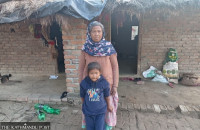National
Qatar approaches Nepal to build international airport in Nijgadh
Qatar has approached Nepal to build an estimated $1.2 billion mega-airport project in Nijgadh, Bara, in a bid to strengthen its presence in Southeast Asia and China in the wake of the blockade imposed by a number of major Arab nations in June 2017.
Sangam Prasain
Qatar has approached Nepal to build an estimated $1.2 billion mega-airport project in Nijgadh, Bara, in a bid to strengthen its presence in Southeast Asia and China in the wake of the blockade imposed by a number of major Arab nations in June 2017.
The airport scheme envisions building a modern airport in Nijgadh, 175km from Kathmandu in the southern plains, as an alternative to congestion and winter fog at Tribhuvan International Airport—the country’s sole aerial gateway.
A highly placed source at the Tourism Ministry revealed that Nepal and Qatar governments “are in talks” to build a new international airport in Nepal, which has been on the drawing board for more than two decades.
Although no formal proposals have been put to Nepal government, senior officials at the ministry and the Civil Aviation Authority of Nepal said that ongoing discussions could yield results soon.
“The issue has been discussed at the highest levels. We have dispatched necessary documents regarding the current status of the project to the Qatar government through its embassy here,” said a senior official at the state-backed civil aviation authority.
“If things go as planned, Prime Minister KP Sharma Oli may visit Qatar in April-May to sign the agreement,” one high-level source at the Tourism Ministry, who asked to stay anonymous, told the Post.
Nijgadh airport was high on the agenda also during President Bidya Devi Bhandari’s visit to Qatar in October last year.
“Since the discussion is in its preliminary phase, the financial modality is not clear yet. It could be a build, own, operate and transfer (BOOT) model or something else,” he said.
“But one thing is clear: the government may award the project through a government-to-government deal.”
BOOT is a public-private partnership project model in which a private firm conducts a large development project under contract to a public-sector partner, such as a government agency.
The government had decided to develop Nijgadh International Airport, one of Nepal’s ambitious projects, in 1995. The timeline for the new airport was pushed back on multiple occasions amid concerns about financing and legal issues over its environmental impact.
The Environmental Impact Assessment report approved by the government shows that more than 2.4 million small and large trees will have to be cut down to build the long-awaited modern international airport in Nijgadh that will have a 4,000-metre runway.
A bevy of foreign investors have expressed interest in building the project, but the government is reluctant to award the contract to anybody, officials said.
The Post has obtained copies of a number of proposals from foreign investors.
One proposal to build the airport has come from a London-based company on November 17, 2016. WGP Global, in association with its project partner Uniel Holdings, has expressed its interest to lead a team to design, construct, finance and manage the project.
“We would be able to introduce leading global financial institutions and other parties which have the experience, capability and interest to participate in the financing of the project—whether in the form of a public-private partnership; BOOT model; or anything else,” WGP Global has said in its proposal.
Similarly, the Malaysian government had on January 6, 2016, proposed implementing a fully-financed construction of the airport under a ‘design, finance, build, operate and transfer’ (DFBOT) model through a government-to-government deal.
“We understand that the Second International Airport [now Nijgadh International Airport] is very critical for the development and growth of Nepal. The Malaysian government and its consortium have a proven track record in terms of experience and expertise in developing and managing international airports all over the world,” said the Prime Minister’s Department, Malaysia in the proposal sent to Nepal’s Tourism Ministry.
“We would like to propose developing the project under the DFBOT model. The Malaysian government will form a consortium of financially strong, well experienced and capable companies to develop and manage the Nijgadh airport,” it added.
Earlier, Landmark Worldwide Company of Korea had proposed to develop the project. The government had awarded a detailed feasibility study contract to the company in March 2010. The Korean company’s report has proposed building the airport under the BOOT model. At the time, the company had estimated a price tag of Rs65 billion for the first phase, Rs7.78 billion for the second phase and Rs8.79 billion for the third phase.
In July 2015, a four-member delegation of the Airport Authority of India visited Kathmandu before heading to Nijgadh for an inspection of the planned airport site.
The visiting delegation had informed Nepali government officials that they were ready to invest in the project, either through the private sector or government funding or both—as per the wish of the Nepal government.
As the international airport in the southern border point would be more accessible for a large population of the Indian states of Uttar Pradesh and Bihar, the southern neighbour is more concerned about it.
But the Nepal government has not been consistent in its policy, as the project’s priority changes whenever the administration changes.
After the Oli administration came to power in February last year, an international airport in Nijgadh has once again emerged as its priority project, with Tourism Minister Rabindra Adhikari making a pitch for developing it as a major transit hub to and from Europe and the United States.




 9.12°C Kathmandu
9.12°C Kathmandu













%20(1).jpg&w=300&height=200)

